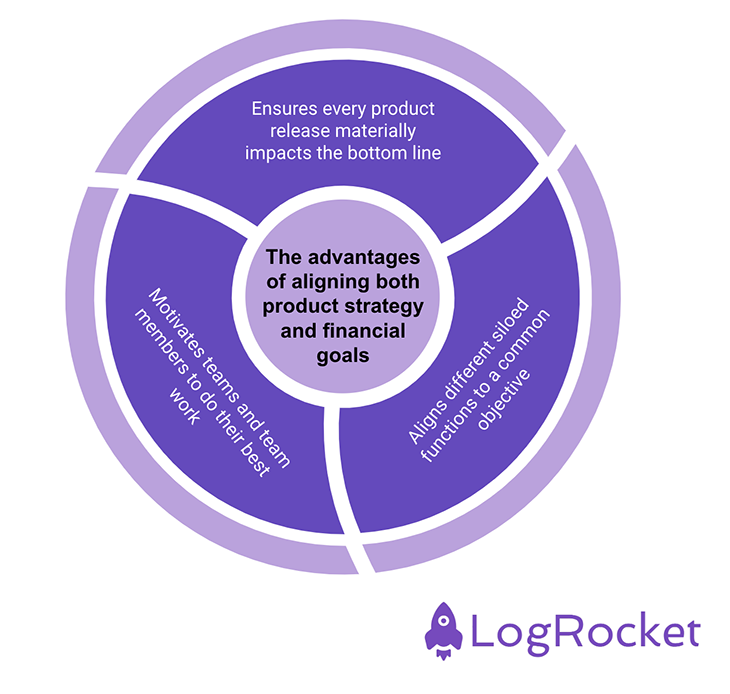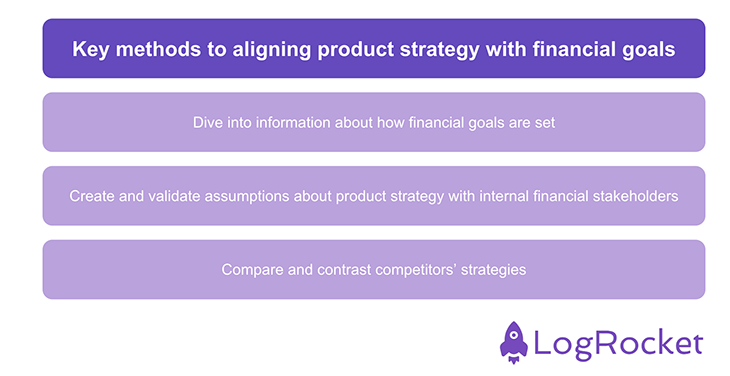Moving up the product management career ladder eventually means moving on from the day-to-day shipping of functions and features. As one moves up in the organization, they’ll begin to make broader contributions to the company, such as setting overall business strategy or driving reputation and profitability.

A key point that every product manager should keep in mind is that it doesn’t matter how many functions or features get released by a team. If they don’t move any sort of needle in the organization in a meaningful way, the amount you ship isn’t relevant.
One of those needles is the profitability needle. Ultimately, the truth of why most companies exist is to make money from customers in their market (unless you are working for a not-for-profit, of course). To ensure that functions and features released by your squad contribute meaningfully, it is important to ensure that any product strategy completely aligns with the financial goals of the company.
Product strategy and financial goals should work in harmony with each other. In this article, we’ll talk about the advantages of aligning product strategy and financial goals, methods to keep them aligned, and steps PMs can take to make this happen.
To determine how to align both product strategy and financial goals, we should start by defining what each of these terms are and what they seek to achieve.
Product strategy is the overall step-by-step method implemented by the organization to achieve its mission and vision. In short, it’s how the organization plans to accomplish its goal with its product and the steps it must take to do so. Product strategy is based on several different factors, such as:
On the flip side of the coin, the financial goals of the company refer to what the company needs to accomplish to not only make an overall profit, but also to build a sustainable business. A company will not just have one figure in mind, — for example, achieving $1 million in annual recurring revenue (ARR) for this financial year — there will be many metrics to measure the overall health of the company.
Key financial measures that may be of interest to companies, no matter where they are in their growth lifecycle, include:
Although it might sound like product strategy and financial goals look to achieve different things, in reality, the product strategy should include overall financial goals! The advantages of doing so are as follows:

Product teams are expected to consider a lot of things — whether that’s from customer feedback or from looking at important metrics on how the product is performing — to make decisions on what kinds of features to work on.
All of these inputs do not matter, however, if they don’t help a for-profit organization achieve its reason for existing — to build a sustainable business by making money. Without making money or improving company profitability, it is unlikely that they will continue to exist.
Product teams should check in to figure out:
These are important metrics for product teams to make sure that they can continue to make money and improve their product overall.
By considering financial goals, product teams can justify future work and measure if the changes they promote in the product make a material difference.
Functions within an organization can be quite fragmented from each other, both in terms of familiarity with what each function actually does and what they want to achieve. Marketing, sales, operations, product, engineering, and design — each of these departments have specific objectives that can be quite disparate from one another. And, as a company grows, so does the separation of each function’s objectives from one another.
A way to mitigate this issue is by ensuring that, above all the individual functions’ concerns and missions, there’s a common, crucial “health metric” for the company. Common health metrics usually include a set of financial goals that represent continued growth and financial security.
On a more granular level, tying product strategy with financial goals has the same effect of ensuring both R&D functions (product, design, and engineering) and finance work hand-in-hand. Decisions made, objectives set, and key results measured should have, in some way, an impact on the overall health of the company.
Ensuring that product releases can make a material, financial impact on the bottom line creates a positive atmosphere within product teams! The features they’re creating not only improve the satisfaction of customers but contribute to the overall profitability of the company.
When team members can see that the work they do helps the organization grow and achieve its health metric goals, morale, and motivation will go up. Product teams may be more willing to go the extra mile and will feel a sense of success.
Despite all the obvious benefits, you’d be surprised by how rare it is to find an organization that can explain how its product strategy will influence or improve the company financially.
There are several tips when trying to rationalize how your product strategy fits in with the wider financial goals of an organization, let’s discuss them below:

When looking to align both product strategy and financial goals, it’s important to take in information without burning too much time upfront. There are two key questions to ask here:
Understanding the two questions above requires consideration of the different jobs-to-be-done (JTBDs) that a customer takes with your product and the value they place on how the product helps them complete their job.
This value can be translated into particular features they use every day. Ways to potentially improve, expand, or introduce features that customers use and care about the most should be considered when thinking about what to do next.
The information that can be reviewed to determine this includes:
Based on the information you collect, make a few assumptions about the kinds of features that customers may be after. How can those features make a material difference to financial goals?
This is not about identifying individual features or functions, as it is unlikely that individual features on their own are capable of this. Rather, it’s about identifying the theme or group of functions that should be discovered, investigated, and expanded upon.
These overarching assumptions should then be discussed and tested internally with teams that have a direct line to the customer and more context on what can help improve the bottom line. After validating them internally, these assumptions can also be brought to customer conversations.
Finally, a crucial but often overlooked step is considering what competitors, whether direct or indirect, are doing. What is their alternative to your product? How do they price this alternative?
Customers will spend their money on the product that helps them get their job done in the most efficient way possible. Although price plays a part in this, features offered by competitors that yours may lack will play a role in your company’s financial success. Understanding how your competitors price their product and their reasons for doing so will help you craft a product strategy that aligns with your financial goals.
Follow the tips above and you’ll be creating a product strategy that aligns with your organization’s financial goals in no time. Until next time!

LogRocket identifies friction points in the user experience so you can make informed decisions about product and design changes that must happen to hit your goals.
With LogRocket, you can understand the scope of the issues affecting your product and prioritize the changes that need to be made. LogRocket simplifies workflows by allowing Engineering, Product, UX, and Design teams to work from the same data as you, eliminating any confusion about what needs to be done.
Get your teams on the same page — try LogRocket today.

A practical framework for PMs to use AI in ideation without sacrificing judgment, strategy, or decision quality.

A practical five minute revenue estimation method to help product managers compare ideas, drop low impact features, and prioritize smarter.

A practical guide for PMs who want to stop being bottlenecks, delegate smarter, and lead teams effectively with a clear ownership framework.

Stop letting unreliable data block features. Treat data as inventory to track quality, ownership, and ship with confidence.